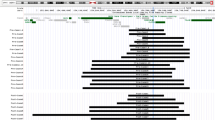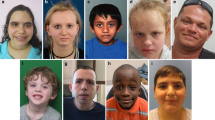Abstract
Microduplications involving the MYT1L gene have mostly been described in series of patients with isolated schizophrenia. However, few reports have been published, and the phenotype has still not been well characterized. We sought to further characterize the phenotypic spectrum of this condition by describing the clinical features of patients with a pure 2p25.3 microduplication that includes all or part of MYT1L. We assessed 16 new patients with pure 2p25.3 microduplications recruited through a French national collaboration (n = 15) and the DECIPHER database (n = 1). We also reviewed 27 patients reported in the literature. For each case, we recorded clinical data, the microduplication size, and the inheritance pattern. The clinical features were variable and included developmental and speech delays (33%), autism spectrum disorder (ASD, 23%), mild-to-moderate intellectual disability (ID, 21%), schizophrenia (23%), or behavioral disorders (16%). Eleven patients did not have an obvious neuropsychiatric disorder. The microduplications ranged from 62.4 kb to 3.8 Mb in size and led to duplication of all or part of MYT1L; seven of these duplications were intragenic. The inheritance pattern was available for 18 patients: the microduplication was inherited in 13 cases, and all parents but one had normal phenotype. Our comprehensive review and expansion of the phenotypic spectrum associated with 2p25.3 microduplications involving MYT1L should help clinicians to better assess, counsel and manage affected individuals. MYT1L microduplications are characterized by a spectrum of neuropsychiatric phenotypes with incomplete penetrance and variable expressivity, which are probably due to as-yet unknown genetic and nongenetic modifiers.
This is a preview of subscription content, access via your institution
Access options
Subscribe to this journal
Receive 12 print issues and online access
$259.00 per year
only $21.58 per issue
Buy this article
- Purchase on Springer Link
- Instant access to full article PDF
Prices may be subject to local taxes which are calculated during checkout

Similar content being viewed by others
Data availability
The datasets generated for the current study are included in this article, further inquiries can be directed to the corresponding authors. The variants reported in patients N1–N5 and described in this study have been submitted to the ClinVar repository (SUB12521627, accession numbers SCV002818537-SCV002818541). All the other newly reported variants have been submitted to the DECIPHER database.
References
Coursimault J, Guerrot AM, Morrow MM, Schramm C, Zamora FM, Shanmugham A, et al. MYT1L-associated neurodevelopmental disorder: description of 40 new cases and literature review of clinical and molecular aspects. Hum Genet. 2022;141:65–80.
Windheuser IC, Becker J, Cremer K, Hundertmark H, Yates LM, Mangold E, et al. Nine newly identified individuals refine the phenotype associated with MYT1L mutations. Am J Med Genet A. 2020;182:1021–31.
Chen J, Lambo ME, Ge X, Dearborn JT, Liu Y, McCullough KB, et al. A MYT1L syndrome mouse model recapitulates patient phenotypes and reveals altered brain development due to disrupted neuronal maturation. Neuron. 2021;109:3775–3792.e14.
De Rocker N, Vergult S, Koolen D, Jacobs E, Hoischen A, Zeesman S, et al. Refinement of the critical 2p25.3 deletion region: the role of MYT1L in intellectual disability and obesity. Genet Med Off J Am Coll Med Genet. 2015;17:460–6.
Manukyan A, Kowalczyk I, Melhuish TA, Lemiesz A, Wotton D. Analysis of transcriptional activity by the Myt1 and Myt1l transcription factors. J Cell Biochem. 2018;119:4644–55.
Lee J, Taylor CA, Barnes KM, Shen A, Stewart EV, Chen A, et al. A Myt1 family transcription factor defines neuronal fate by repressing non-neuronal genes. eLife. 2019;8:e46703.
Mall M, Kareta MS, Chanda S, Ahlenius H, Perotti N, Zhou B, et al. Myt1l safeguards neuronal identity by actively repressing many non-neuronal fates. Nature. 2017;544:245–9.
Pang ZP, Yang N, Vierbuchen T, Ostermeier A, Fuentes DR, Yang TQ, et al. Induction of human neuronal cells by defined transcription factors. Nature. 2011;476:220–3.
Vierbuchen T, Ostermeier A, Pang ZP, Kokubu Y, Südhof TC, Wernig M. Direct conversion of fibroblasts to functional neurons by defined factors. Nature. 2010;463:1035–41.
Lee Y, Mattai A, Long R, Rapoport JL, Gogtay N, Addington AM. Microduplications disrupting the MYT1L Gene (2p25.3) are associated with schizophrenia. Psychiatr Genet. 2012;22:206–9.
Braddock A, Del Campo M, Reiff MI, Stein MT. Disruptive behavior, global developmental delay, and obesity in a 5-year-old boy with a chromosome microduplication. J Dev Behav Pediatr JDBP. 2018;39:81–4.
Coe BP, Witherspoon K, Rosenfeld JA, van Bon BWM, Vulto-van Silfhout AT, Bosco P, et al. Refining analyses of copy number variation identifies specific genes associated with developmental delay. Nat Genet. 2014;46:1063–71.
Cooper GM, Coe BP, Girirajan S, Rosenfeld JA, Vu TH, Baker C, et al. A copy number variation morbidity map of developmental delay. Nat Genet. 2011;43:838–46.
International Schizophrenia Consortium. Rare chromosomal deletions and duplications increase risk of schizophrenia. Nature. 2008;455:237–41.
Jakobsson M, Scholz SW, Scheet P, Gibbs JR, VanLiere JM, Fung HC, et al. Genotype, haplotype and copy-number variation in worldwide human populations. Nature. 2008;451:998–1003.
Mansfield P, Constantino JN, Baldridge D. MYT1L: A systematic review of genetic variation encompassing schizophrenia and autism. Am J Med Genet Part B Neuropsychiatr Genet Off Publ Int Soc Psychiatr Genet. 2020;183:227–33.
Meyer KJ, Axelsen MS, Sheffield VC, Patil SR, Wassink TH. Germline mosaic transmission of a novel duplication of PXDN and MYT1L to two male half-siblings with autism. Psychiatr Genet. 2012;22:137–40.
Suktitipat B, Naktang C, Mhuantong W, Tularak T, Artiwet P, Pasomsap E, et al. Copy number variation in Thai population. PloS One. 2014;9:e104355.
Van Den Bossche MJ, Strazisar M, Cammaerts S, Liekens AM, Vandeweyer G, Depreeuw V, et al. Identification of rare copy number variants in high burden schizophrenia families. Am J Med Genet Part B Neuropsychiatr Genet Off Publ. Int Soc Psychiatr Genet. 2013;162B:273–82.
Vrijenhoek T, Buizer-Voskamp JE, van der Stelt I, Strengman E, Genetic Risk and Outcome in Psychosis (GROUP) Consortium, Sabatti C, et al. Recurrent CNVs disrupt three candidate genes in schizophrenia patients. Am J Hum Genet. 2008;83:504–10.
Walsh T, McClellan JM, McCarthy SE, Addington AM, Pierce SB, Cooper GM, et al. Rare structural variants disrupt multiple genes in neurodevelopmental pathways in schizophrenia. Science. 2008;320:539–43.
Stevens SJC, van Ravenswaaij-Arts CMA, Janssen JWH, Klein Wassink-Ruiter JS, van Essen AJ, Dijkhuizen T, et al. MYT1L is a candidate gene for intellectual disability in patients with 2p25.3 (2pter) deletions. Am J Med Genet A. 2011;155A:2739–45.
Firth HV, Richards SM, Bevan AP, Clayton S, Corpas M, Rajan D, et al. DECIPHER: database of chromosomal imbalance and phenotype in humans using ensembl resources. Am J Hum Genet. 2009;84:524–33.
Buizer-Voskamp JE, Muntjewerff JW, Strengman E, Sabatti C, Stefansson H, Vorstman JA, et al. Genome-wide analysis shows increased frequency of CNV deletions in Dutch schizophrenia patients. Biol Psychiatry. 2011;70:655–62.
Blanchet P, Bebin M, Bruet S, Cooper GM, Thompson ML, Duban-Bedu B, et al. MYT1L mutations cause intellectual disability and variable obesity by dysregulating gene expression and development of the neuroendocrine hypothalamus. Stark Z, éditeur. PLOS Genet. 2017;13:e1006957.
Girirajan S, Rosenfeld JA, Coe BP, Parikh S, Friedman N, Goldstein A, et al. Phenotypic Heterogeneity of Genomic Disorders and Rare Copy-Number Variants. N Engl J Med. 2012;367:1321–31.
Girirajan S, Eichler EE. Phenotypic variability and genetic susceptibility to genomic disorders. Hum Mol Genet. 2010;19:R176–87.
Do KQ, Cabungcal JH, Frank A, Steullet P, Cuenod M. Redox dysregulation, neurodevelopment, and schizophrenia. Curr Opin Neurobiol. 2009;19:220–30.
Ramos PS, Sajuthi S, Langefeld CD, Walker SJ. Immune function genes CD99L2, JARID2 and TPO show association with autism spectrum disorder. Mol Autism. 2012;3:4.
Rosenfeld JA, Ballif BC, Torchia BS, Sahoo T, Ravnan JB, Schultz R, et al. Copy number variations associated with autism spectrum disorders contribute to a spectrum of neurodevelopmental disorders. Genet Med. 2010;12:694–702.
Acknowledgements
We thank the patients and their families for their cooperation. This study assessed data generated by the DECIPHER community. A full list of the centers that helped to generate the data is available from https://deciphergenomics.org/about/stats and by e-mail from contact@deciphergenomics.org. Funding for the DECIPHER project was provided by the Wellcome Trust. We declare that those who carried out the original analysis and collection of the data bear no responsibility for the further analysis or interpretation of the data.
Funding
This research did not receive any specific grant from funding agencies in the public, commercial, or not-for-profit sectors.
Author information
Authors and Affiliations
Contributions
MB, FV and BH: contributed to the study conception and design. MB: analyzed the data and wrote the manuscript. JL, GL, FB, MGG, RD: performed the clinical evaluation of the patients. ME, NC, LB, ACT, CSB, JCo: performed the genetic investigations. JCl: participated in the collection of clinical data. FV, BH: did the supervision, review and editing of the manuscript. All authors contributed to data acquisition.
Corresponding authors
Ethics declarations
Ethical approval
In compliance with the Declaration of Helsinki, informed written consent for genetic study was obtained for participated individuals.
Competing interests
The authors declare no competing interests.
Additional information
Publisher’s note Springer Nature remains neutral with regard to jurisdictional claims in published maps and institutional affiliations.
Rights and permissions
Springer Nature or its licensor (e.g. a society or other partner) holds exclusive rights to this article under a publishing agreement with the author(s) or other rightsholder(s); author self-archiving of the accepted manuscript version of this article is solely governed by the terms of such publishing agreement and applicable law.
About this article
Cite this article
Bouassida, M., Egloff, M., Levy, J. et al. 2p25.3 microduplications involving MYT1L: further phenotypic characterization through an assessment of 16 new cases and a literature review. Eur J Hum Genet 31, 895–904 (2023). https://doi.org/10.1038/s41431-023-01379-9
Received:
Revised:
Accepted:
Published:
Issue Date:
DOI: https://doi.org/10.1038/s41431-023-01379-9
This article is cited by
-
A new impact factor for EJHG in 2022
European Journal of Human Genetics (2023)



